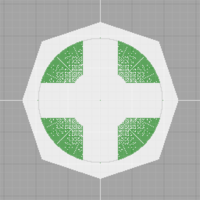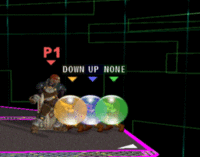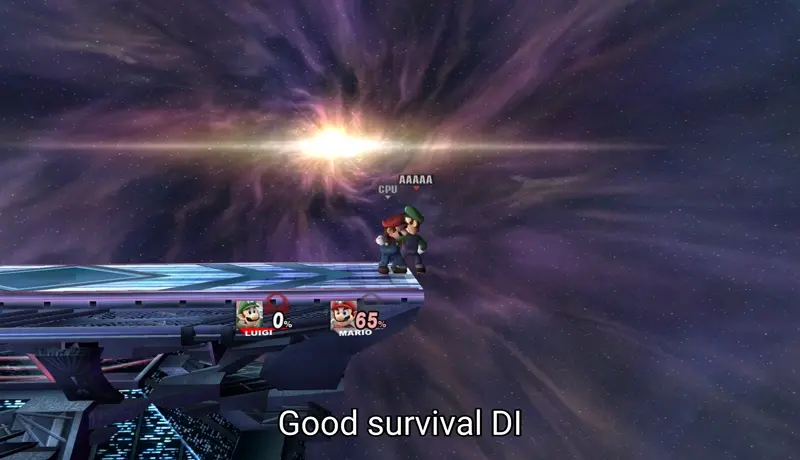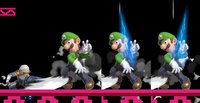Directional influence
Directional influence (usually abbreviated DI, and known officially as launch shuffling) is the control the receiver of an attack has over their trajectory. Each attack sends its target in a particular direction; DI can be used to alter, but not completely change, this original trajectory. DI is executed by holding the control stick in any direction during freeze frames from an attack, before the character is launched.
Directional influence is used for different purposes depending on a player's situation when hit by an attack. There are two main applications for DI: combo DI and survival DI, both based on the same game mechanics. Combo DI refers to a player altering their knockback trajectory at low percentages while getting comboed. This makes it more difficult for the opponent to follow up or extend their combo, and can allow the player to escape some setups, such as the space animal slayer in Melee.
Survival DI refers to a player altering their knockback trajectory at high percents in order to increase their travel distance towards the blast line. Good survival DI produces a trajectory that creates the greatest distance between the character and the blast line, or one that will help the character recover back on stage. In most situations, angling towards the upper-left or upper-right corners will grant the greatest chance of surviving a high knockback attack. This means DI'ing to the side when hit by a vertical attack, or DI'ing upwards when hit by a horizontal attack. Good DI allows a player to survive high-knockback attacks to higher percents than they would with no DI inputs.
Conversely, "poor DI" (often informally referred to with some form of mockery towards a certain region/player, such as "West Coast DI", or "PatG DI" in Brawl) occurs when the shortest distance between the character and the blast line is created, or the angle sends the player into a position they cannot recover from when they normally easily would, such as down and away from the stage. All control stick inputs will result in a DI input when a player is hit by an attack, so a player inputting another action (such as dashdancing) while getting hit can result in poor DI. Bad DI that results in a KO commonly occurs near the sides of the stage, when a character is hit diagonally while holding the control stick downward (commonly as a result of intentional fast falling), which sends them on a more horizontal trajectory, towards the closest blast line.
The technique should not be confused with smash directional influence (also known as smash DI or SDI). Although both techniques are used for escaping combos and surviving high knockback attacks, smash DI refers to altering a character's position during freeze frames, and the two are completely separate mechanics.
For characters on the ground, DI does not work against knockback that keeps them on it, such as low knockback from meteor smashes or attacks with the Sakurai angle.
In Super Smash Bros.[edit]
Directional influence does not exist in the original Super Smash Bros.; only smash directional influence does. Coupled with hitstun being much higher than in later installments, this contributes to the ease of combos in said game; there is usually no way for a character to escape a combo once it has been started, often leading to a zero-to-death.
An advanced technique exclusive to this game, known as Ledge DI, involves using SDI into the lower right portion of the ledge. If done correctly, the fighter would pop upward back onto the stage.
In Super Smash Bros. Melee[edit]

In Melee, DI is essential for escaping many combos, especially chain grabs. Effective DI allows players to survive up to higher damage percentages than usual.
Mechanics[edit]
To determine the effective trajectory, the position of the control stick is read on the last frame of hitlag. ASDI is usually triggered by this as well. The highest deviation of trajectory is produced by directions perpendicular to the original knockback angle of the hitbox and amounts to approximately 18°, while also depending on how much the control stick is tilted in said direction; tilting it by a lesser amount will cause a weaker deviation. Holding directions that are parallel to the original angle will produce no survival DI at all. Because the possible DI angles are not distributed equally (see diagram to the right), knockback angles within 17° of vertical or horizontal can be trajectory DI'd to a lesser degree, as no true correspondent perpendicular angle is available.
DI strategies[edit]
What DI is optimal depends on the circumstance. When players DI to survive moves that might otherwise KO, it is called survival DI. When players DI to escape follow-up moves that would otherwise combo, it is called combo DI.
Survival DI[edit]
Survival DI consists of altering the knockback direction towards the upper corners of the screen so that more distance is required to reach the blast lines, effectively preventing a KO if the knockback was high enough to push the character into them with the original trajectory, but not enough to do so with the new trajectory created by the DI. Usually, if the attack's trajectory is almost entirely vertical, merely holding the control stick horizontally is needed, while if it is more horizontal, it must be held in a diagonally upward angle.
Combo DI[edit]
Because of the high amount of hitstun in Melee (or, more accurately, the lack of the ability to negate hitstun), especially compared to Brawl, it is often possible to hit the opponent with another attack while they are still in hitstun. By DIing away from the attacker, the victim can increase the distance the attacker needs to travel and thus make it harder for the attacker to reach them in time to continue the combo.
Most of the time, combo DI is as simple as holding horizontally to the knockback direction. Against characters like Captain Falcon who have aerials with high knockback and low ending lag, it is often hard to decide between survival DI and combo DI. While combo DI might escape a consecutive hit, it might also be enough to pass the horizontal blast zones and get KOed. Survival DI ensures the KO doesn't happen, but it might make it easier for Captain Falcon to land another aerial.
DI mixups[edit]
Because survival DI generally involves DIing upwards, and combo DI generally involves DIing outwards and away, the combo game in Melee often comes down to a series of DI mixups. Using survival DI on a weak hit can lead to easy followups by the opponent, while using combo DI on a strong move can result in getting KOed at extremely low percents. Many players will preemptively DI outward while getting comboed. As a result, the attacking player will often throw out an unexpected move which punishes the player for their DI. Powerful horizontal moves are most frequently used as DI mixups, because a poorly DI'ed horizontal move can KO extremely early off the side blast zones, or send the opponent too far from the stage to recover. Falco's forward smash and Marth's forward smash are two of the most commonly used DI mixups.
In Super Smash Bros. Brawl[edit]
In Brawl, DI operates identically to how it does in Melee. However, one major change is that DI no longer works on knockback that does not cause tumbling, regardless of the direction held on the control stick; this is most notable with throws that have low base knockback, such as Pikachu's down throw. This facilitates the execution of low percent combos, such as Kirby's Gonzo combo, but has also resulted in infamously stronger, inescapable chaingrabs and zero-to-deaths, namely the aforementioned Pikachu down throw and Sheik's forward tilt on the space animals, and King Dedede's down throw on non-lightweight characters, which is made more problematic by the changes to stale-move negation causing moves' knockback to be decreased much more significantly if staled.
In cases where it is possible, DI in Brawl is not as useful as it was in Melee for escaping combos, due to the introduction of hitstun canceling and slower falling speeds making them much more difficult nearly to the point of nonexistence. However, DI is easier to perform due to longer hitlag, and still proves very effective for surviving at high percents, especially coupled with momentum canceling, a technique introduced as a result of hitstun canceling that significantly extends the durability of characters compared to Melee.
In Super Smash Bros. 4[edit]
In Smash 4, DI has been made only half as effective, reducing its maximum angle deviation to 0.17 radians (approximately 9.74°). Additionally, a second type of directional influence has been introduced, which alters the character's launch speed depending on the control stick's vertical position, so that holding upward increases their launch speed (and therefore how far they travel), and holding downward decreases it. This is known as launch speed influence (LSI for short), and was originally known as vectoring (name coined by Strong Bad, who first published the Smashboards post), due to being initially believed to apply a vector to the character's knockback in any desired direction.[1]
LSI depends on how far the control stick is tilted in the appropriate vertical direction, multiplying a character's launch speed by x1.095 if tilted upward to the maximum and by x0.92 if tilted downward to the maximum. Like DI, LSI is determined on the last frame of hitlag right before the character is launched, and does not take effect on knockback that does not cause tumbling. This means that generally, moves with predominantly horizontal angles can have the player either pick between DIing high to aim themselves more vertically at the cost of being launched farther, or DIing low to reduce resulting knockback at the cost of ending up in a lower, less favorable position.
The narrower angle change provided by DI in Smash 4, coupled with LSI's aforementioned effects, significantly reduce its effectiveness for escaping combos and surviving KO moves for longer, as less space is created between the victim and an attacker wishing to continue a combo, while DIing horizontal launchers at high angles to prevent edgeguards and center stage KOs now results in increased distance away from the stage and the resulting angle not being as vertical as before. DI continues to be a useful technique in competitive play regardless, however, as it still has a significant effect in moderately strong moves that can otherwise secure KOs under certain conditions, such as throws boosted by rage near the edge, and with the changes to hitstun canceling from Brawl making true combos prevalent again, it can be used to avoid certain deadly setups and/or 50-50s such as Captain Falcon's down throw into Knee Smash from a dash grab.
During the initial release of Super Smash Bros. for Nintendo 3DS, LSI affected any angle with no restriction, giving it a significant effect on moves with largely vertical angles, while not incurring any significant compromise in DI due to the control stick already having to be held entirely vertically to achieve the full effect of LSI. More specifically, vertical finishers (like most up smashes) and meteor smashes could be survived for longer by holding down, while vertical combo moves (like most down throws) would stop working earlier if the victim held up to be launched farther away from the attacker via LSI. Starting in patch 1.0.4, LSI has no effect if the launch angle is between 65° and 115°, or between 245° and 295°, preventing such moves from having their knockback altered by it and leaving DI as the only other, much less significant option against them.[2] However, this restriction takes DI into account rather than reading the base angle, which allows moves with angles differing from any of these thresholds by less than ≈9.74° (the highest angle difference caused by DI), such as 73°, to still fall out of range and be affected by LSI, disproportionately so compared to moves with other launch angles. The most notable example of this fault is Charizard's up throw, which can normally KO at around 125%, but due to its angle of 70°, DIing it at roughly 295° deviates it enough to get it out of the LSI-disabled range and therefore creates both optimal DI and LSI, rendering the move unable to KO until around 155%; this is in stark contrast to Mewtwo's up throw, which due to its angle of 90°, is immune to LSI and barely affected by DI, only KOing 4% later with the latter in effect.
In Super Smash Bros. Ultimate[edit]
Ultimate reuses the directional influence mechanics from the latest version of Smash 4, with both DI and LSI being present, and the latter still having a restriction for vertical angles. As a new aesthetic indicator, when DI is applied, the game briefly displays a streak of blue light pointing along the character's final launch angle. Additionally, during a Special Zoom or Finish Zoom, the window for the victim to DI ignores the slowdown effect, preventing them from having more time to DI properly and survive for longer when either event occurs.


